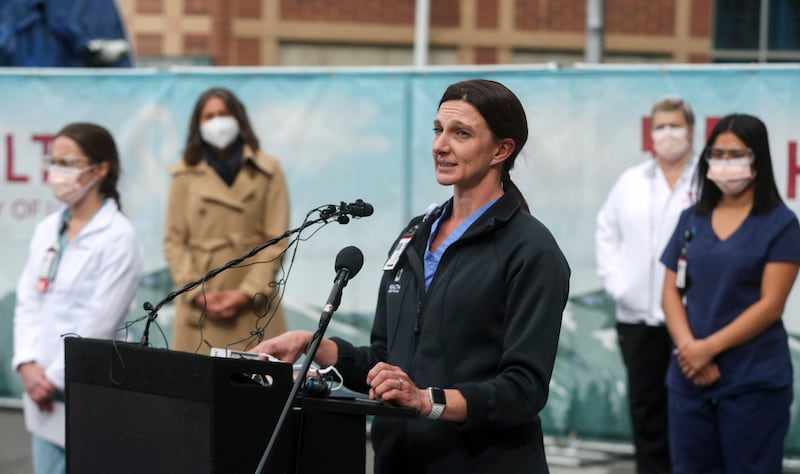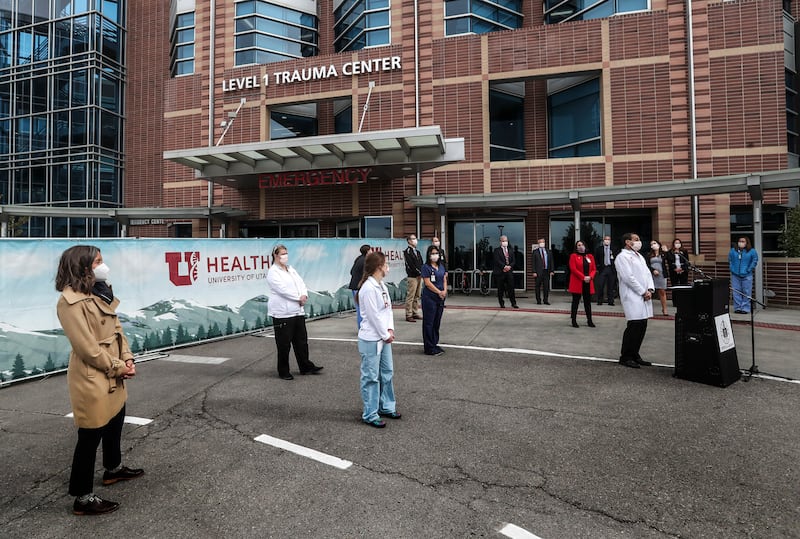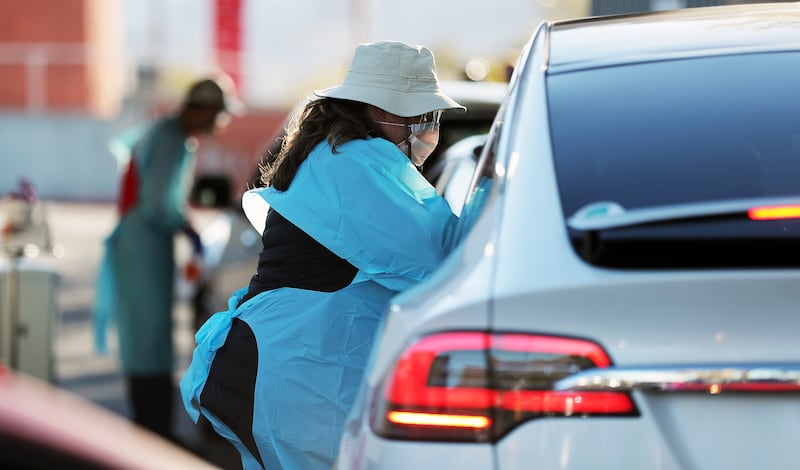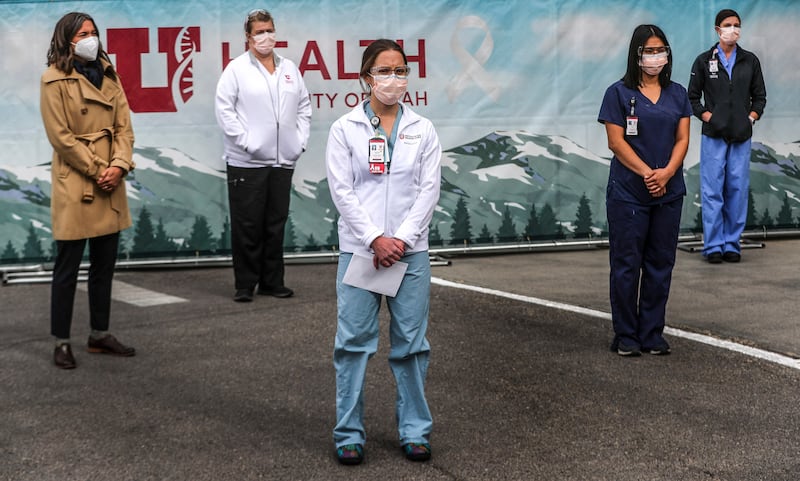SALT LAKE CITY — When intensive care nurse Katrina Emery early this year began preparing for COVID-19 to possibly hit Utah, she says she “never imagined we would be where we are today.”
“I was part of the initial team that began preparing for COVID patients in the event the virus made its way to Utah. COVID has consumed my life since February, and it has terrified me,” said Emery, with University of Utah Health.
“Our ICUs are pushed to their capacities, and our hospital staff is stretched thin. ... But each day, we continue to show up because if we don’t, who will?” Emery asked as she and others with the hospital gathered outside to discuss the health care system’s current, troubling situation as it battles the disease.
Utah recorded an incredible 1,960 new COVID-19 cases on Friday — shattering the daily record that was set just a day earlier of 1,543.
The seven-day average for new cases stands at 1,355, with the average positive test rate at 15.8%.
Hospitalizations also continued to rise in the Beehive State, with a total of 313 patients being treated in hospitals on Friday — 12 more than were hospitalized the previous day.
Officials with the University of Utah Health announced Friday its ICUs are at 99% capacity.

“We’re here because in the face of a continually rising case count and hospital capacity moving toward a breaking point, we feel compelled to communicate to everyone who will listen to the true severity of what is happening with this pandemic in the state of Utah,” Salt Lake City Mayor Erin Mendenhall said during the news conference in front of the entrance of University of Utah Hospital.
She said she believes the “distance” between those who have the disease and health care workers, and those who haven’t been touched by the disease personally, has led to the rising case numbers.
“It has given us the permission to insulate ourselves from the long and difficult shifts that our nurses, doctors and support staff are working around the clock, exhausted. And it’s insulated us from the nearly 600 Utah families who have lost their loved ones,” Mendenhall said. “Let us not allow our inability to see inside that medical unit blind us from the reality that we face in Utah today.”
She asked residents to temporarily sacrifice comforts like seeing friends and family to help health care workers and protect others.
Emery said one of the most difficult aspects of treating COVID-19 patients is seeing them sit alone in a hospital room for weeks or months.
“My patients have told me that they are lonely and scared. Lonely, because many times, we don’t speak the same language. Scared because they can’t breathe, and scared that they may never experience life outside the hospital walls.”
She said in her several years as an intensive care nurse, she’s never seen units so busy. While she normally works 36 hours a week, she and other full-time nurses are working closer to 50 hours.
“This isn’t sustainable, and we’re exhausted,” Emery said, becoming emotional.
And bringing new nurses into the job isn’t a simple solution, she said, as it takes months of training in an intensive care unit.

“This hasn’t been easy for anyone, but all that I ask is that you do what you can to protect yourself, protect me, and protect our communities,” Emery said.
“We need you as our community more than ever. We need you to wear your mask when you leave your house. We need you to wear your mask when you’re with anybody besides who you live with, because until you do that, we will have 99% plus ICU capacity,” said Dr. Kencee Graves, U. Health assistant chief medical officer of inpatient patient care.
And statewide hospital bed capacity isn’t representative of the true burden providers face. “A hospital bed is meaningless if you do not have a doctor and a nurse to take care of you, or a PA and an NP,” Graves said.
Patients get referred to the University of Utah Hospital from neighboring states, some of whom need surgeries to improve their quality of life. And they are seeing their procedures delayed due to the increase in COVID-19 patients.
“We have a lot of responsibility to care for people with life-limiting or significant quality of life problems and the problem that we’re running into as our hospital fills with COVID patients, and we so desperately want to care for patients, is that run on our health system capacity is competing directly with our ability to care for non-COVID patients,” said Dr. Robert Glasgow, professor in the department of surgery.
He said surgeries have been canceled for patients who require a hospital stay.
“Due to the large numbers in COVID-infected patients, we have pulled nurses, respiratory therapists, physicians, physical therapists, pharmacists, all over our health care system and other clinics in other areas where we provide care. This obviously reduces our ability to care for non-COVID patients,” said Dr. Nathan Hatton, associate professor of pulmonary medicine and associate medical director of the medical intensive care unit.
“For instance, if you have hypertension, or diabetes, or COPD, you might not be able to see a provider as quickly or have your health care needs met because we are under so much strain in our hospital system,” Hatton said.

New cases, deaths
On Friday, 1,960 cases were reported out of 8,454 tests, with a 23.2% positive rate. They topped Thursday’s record of 1,543 cases and continued a streak of now 10 straight days with more than 1,000 new COVID-19 infections diagnosed.
The state has now seen 101,509 novel coronavirus cases confirmed out of 1,012,740 people tested since the pandemic hit earlier this year. Hospitalizations since the start of the outbreak now total 4,939.
Gov. Gary Herbert also sounded an alarming tone in a statement released Friday as the high case count was reported.
“Today we stand on the brink. If Utahns do not take serious steps to limit group gatherings and wear masks, our health care providers will not have the ability to provide quality care for everyone who needs it,” Herbert said.
Health officials also reported four more deaths, bringing the state’s toll to 567. The victims were: two Salt Lake County men, one between ages 45 and 64 and the other age 65-84, both hospitalized at time of death; a Davis County man age 45-64, also hospitalized; and a Washington County man over 85 who was in a long-term facility.
The continuing surge led the state on Thursday to place all but eight counties into its high level of transmission category, which places mask requirements in public settings and limits gatherings to 10 or fewer.


